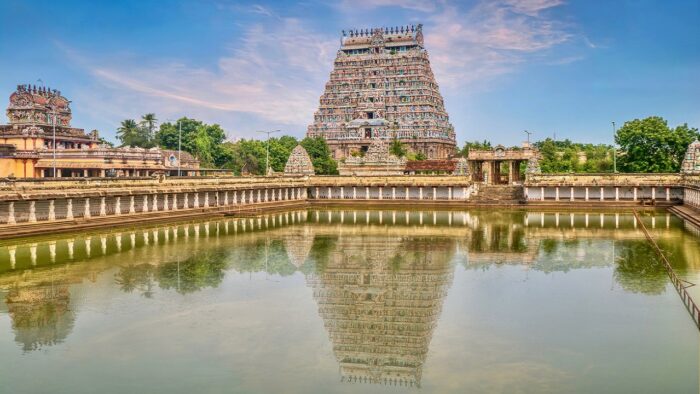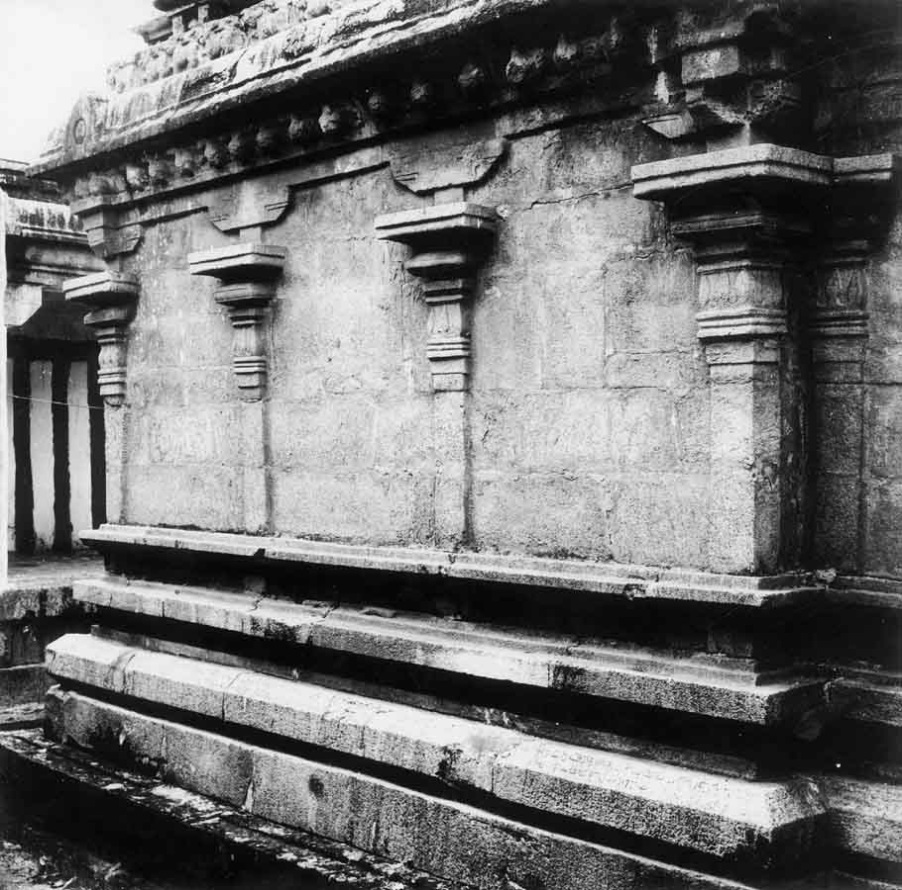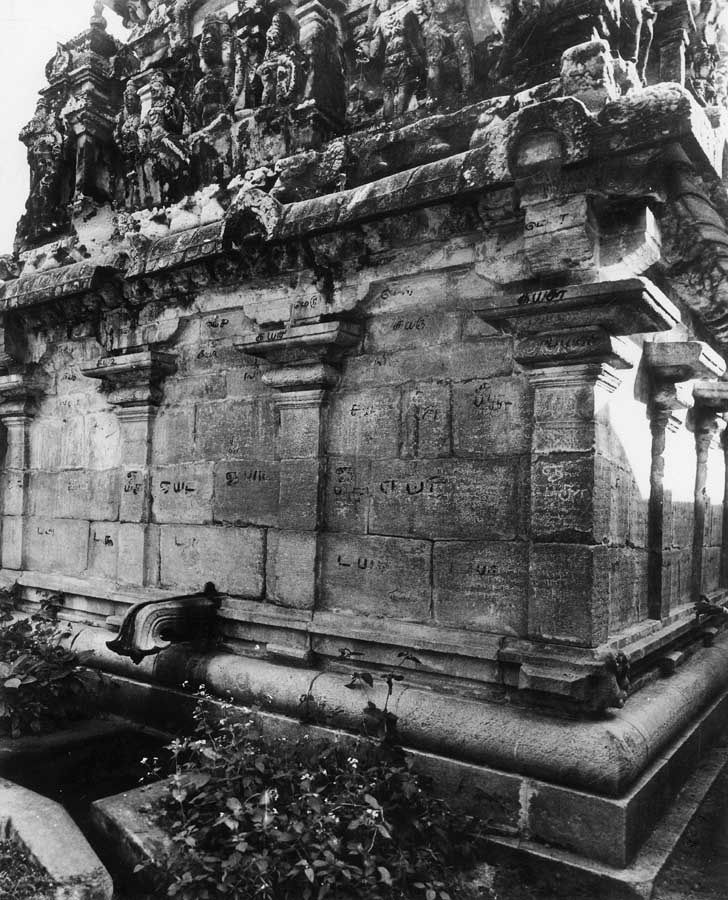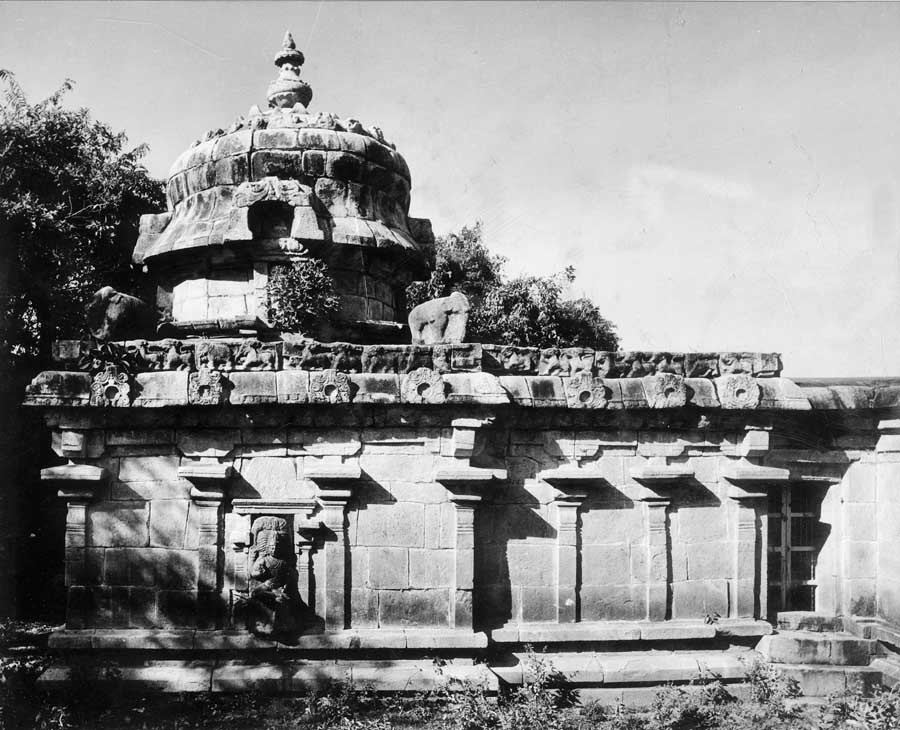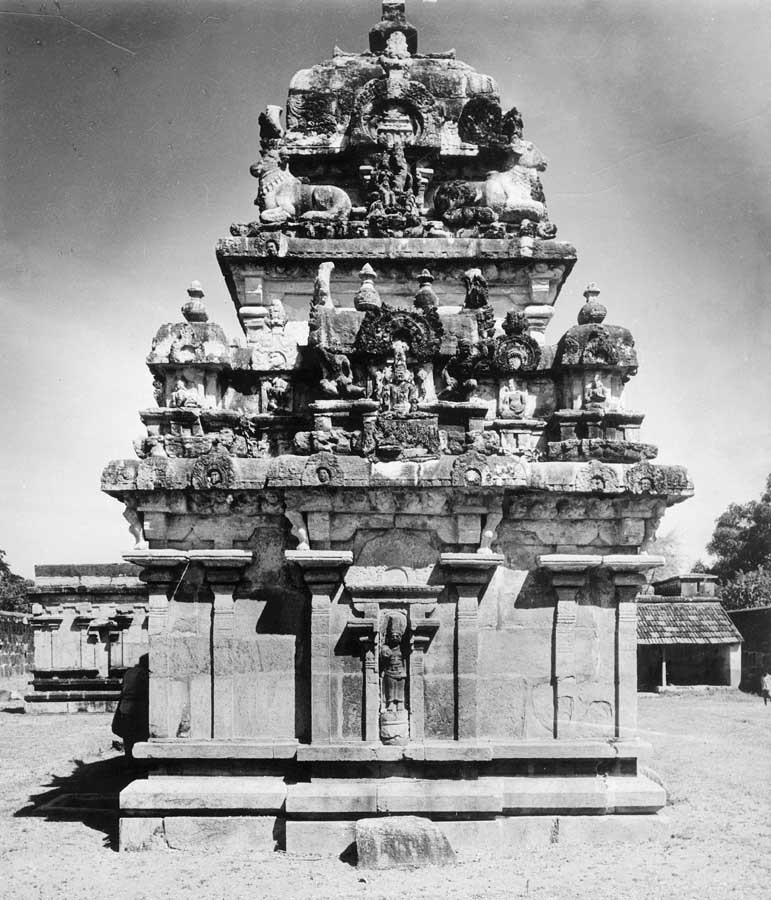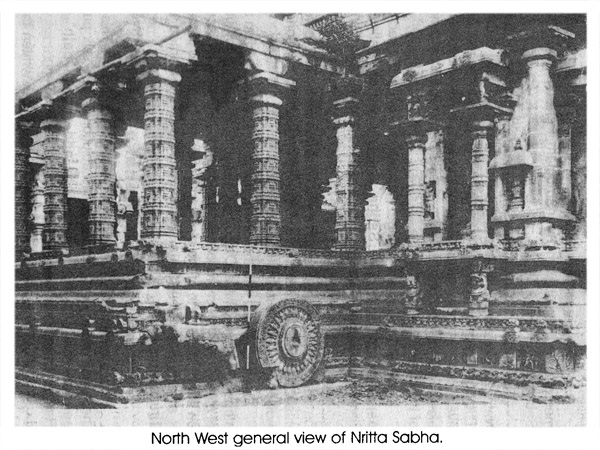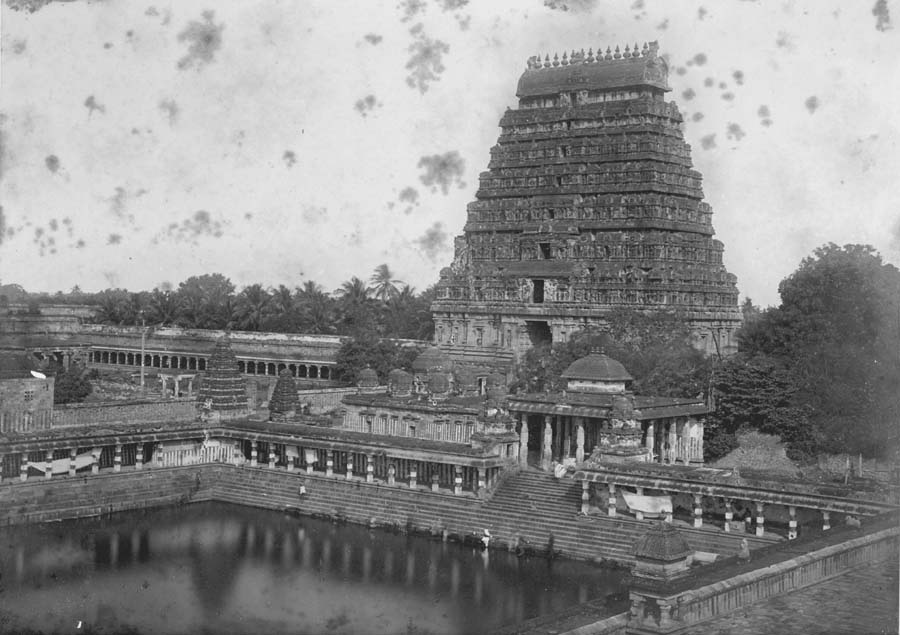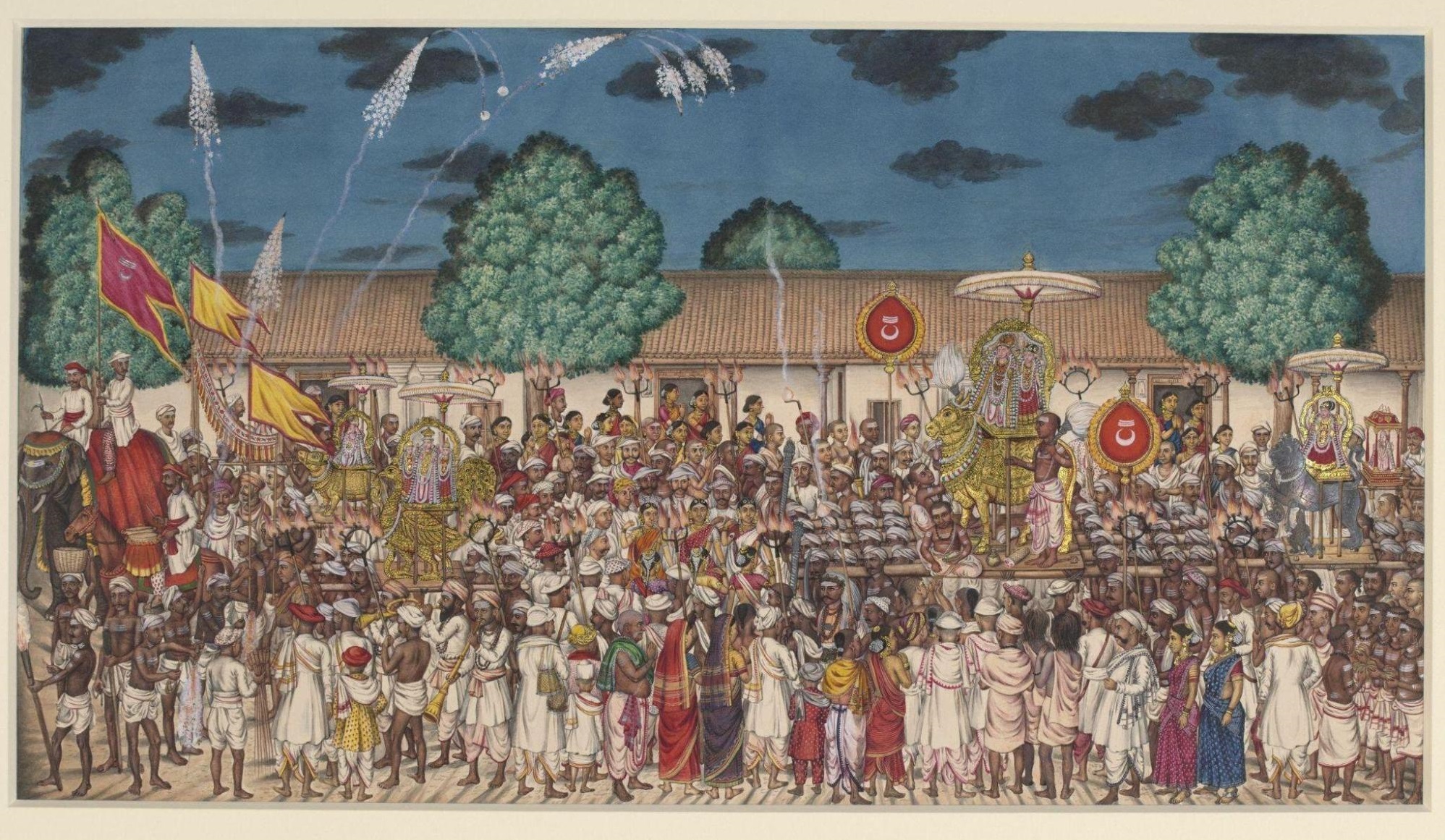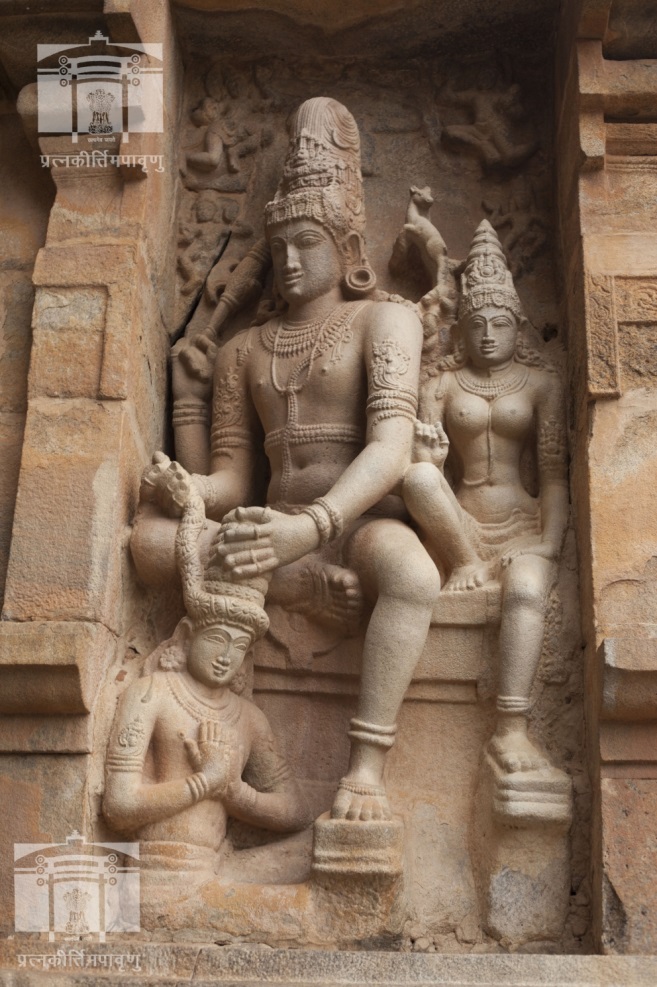Abstract
What does it mean to look at a temple and call it a ‘Chola structure?’ Did a Chola king patronise his construction? Did we excavate it in erstwhile Chola territory? Does it carry stylistic characteristics unique to the Cholas? Clearly, the ease with which we throw around dynastic labelling remains precarious and needs re-examination. This paper argues that our basic understanding of a ‘Chola temple’ is tainted by the overuse of dynastic labelling; this understanding being its very nature. I seek to argue that since early medieval South Indian dynasties fought for territories common to the whole region, the delineation of boundaries often remained blurred. Inadvertently – or perhaps out of convenience – the structural remains of these regions (secular or religious) tended to be stylistically similar, since all these dynasties were wresting control of the same region from one or the other. Not surprisingly, distinctly different dynasties produced (and reworked) temples that were similar in form, shape, and design. Therefore, unless revised, dynastic labelling becomes pointless in such a situation. This is where I introduce the Chidambaram temple. To apply a dynastic label, I shall seek to go beyond stylistic aspects and focus on other contextual realities that were unique to the Cholas and clearly defined in spaces like the Chidambaram temple. Only through such an examination shall we improve our present knowledge about Chola temples.
Situating the Cholas
For a thalassocratic dynasty that is touted to be one of the longest ruling in world history, there is extraordinarily little information available regarding the origins of the Cholas. The earliest mentions date back to the Tamil corpus of texts, the Sangam literature, in 150 CE (Sastri, 1984, p. 3). Further fragmentary information is gleaned from secular and religious texts, and stone and copper inscriptions. The Periplus of the Erythraean Sea – a Greco-Roman manuscript which details trading and navigation along Roman and Egyptian ports – along with the geographic writings of Ptolemy briefly note the body of commerce that passed through Chola ports and South India (Sastri, 1984, p. 20). Several Ashokan Pillars mention the Cholas as a kingdom on friendly terms with the Mauryans, and the Buddhist text from the 5th century CE, Mahavamsa details the Chola campaigns in Northern Sri Lanka (Bowman, 2000, p. 401).
Our scant fortunes are reversed by the 9th century, when an imperial and centralised Chola state begins to emerge. To fully understand the implication of what makes a Chola temple so, Noboru Karashima’s (2014) succinct study of the fractious power dynamic that these Cholas had to negotiate with can be examined. The first Chola King, Vijayalaya, was a feudal lord of the Pallavas when they, along with the Pandyas and the Rashtrakutas, were fighting each other for hegemony. It was during this period that Vijayalaya usurped against his feudal overlords and took over Thanjavur from the Muttaraiyars. Vijayalaya’s independent position was further strengthened with the annexation of Tondai-mandalam, when the second Chola king Aditya killed the Pallava king Aparajita in battle.
The ascendancy of the Cholas suffered a setback when the Chola king Parantaka I, known as the ‘Conqueror of Madurai,’ was defeated by the Rashtrakuta king Krishna III at the battle of Takkolam in 949. The principal concern of the Rashtrakutas was to control the regions of Tondai-mandalam and the occupation of the Andhra region, especially Vengi, from the Eastern Chalukyas. The Cholas were simply an obstacle in the way. It was only in 973, when Taila II of the Chalukyas defeated the Rashtrakutas, that the Cholas found solid footing again. It was here that kings Rajaraja I (985-1014) and Rajendra I (1012-44) took the Chola dynasty to its greatest height.
The initial campaigns of Rajaraja resulted in the defeat of the Cheras at Kandalur, the Pandyas at Madurai, and Sri Lankan rulers by occupying Anuradhapura in the north. These victories were extended to the regions of the Gangas in southern Mysore and the Chalukyas. Although the Chalukyas were steadily increasing their power under the kingship of Taila II, the Cholas quickly advanced over the eastern and western Deccan, conquering vast swathes of the Tungabhadra region, and took over the Chalukyan capital Manyakheta. Rajaraja further went on to control the East-West maritime trade in the Indian Ocean by attacking the Maldives. Rajaraja’s work was continued with his successor Rajendra I, who finally conquered Vengi and subdued the Eastern Gangas. He commemorated his victory by adopting the title Gangaikondachola, or ‘the Chola king who took the Ganga,’ and established his new capital Gangaikondacholapuram. Rajendra sent several naval expeditions to the Strait of Malacca and China to monopolise the Chola maritime trade, and sacked Srivijaya.
By the time Somesvara I occupied the Chalukyan throne in 1042 (who shifted his capital from Chola held Manyakheta to Kalyani), conflict between the Cholas and the Chalukyas flared up again. The position of the Cholas became precarious with the northern and southern division of the Chalukyas under Somesvara II and Vikramaditya respectively, which increasingly strained Chola control of Vengi. When Kulottunga I rose to power, the Cholas had lost their Sri Lankan territories and the Pandyas were rebelling in southern Tamil Nadu. Kulottunga therefore focused on domestic administration and consolidation rather than expansion. While the Chalukyan rule was threatened with the rise of the Hoysalas and the Kakatiyas, the Cholas, under Kulottunga’s successor Vikramchola (1118-35), started suffering from financial issues, tax arrears, and volatile local chieftains who began increasing their own power and influence. By the time we come to Kulottunga III’s reign (1178-1218), Chola power was witnessing its last flourish (the Chalukyas were suffering a similar fate, with the Kalachuris, Seunas, and the Hoysalas destroying the Chalukyan state, making Somesvara IV its last king).
The Problem of Labelling a ‘Chola’ Temple
The imperial Cholas’ rise to power was clearly no small feat. In their efforts to occupy and control lands stretching from South India to Sri Lanka, Malaysia, and Indonesia, the Chola dynasty was constantly at war with multiple kingdoms. However, the consequence of such campaigns was not simply limited to the political and military realm. By incorporating such varied regions under their rule, the Cholas sought an opportunity to foster and patronize the development of an extraordinary artistic and religious vocabulary. This not only led to the growth of the religious Shaivite and Vaishnavite cults but also the aesthetic idiom of what we today call ‘Chola bronzes,’ and more pertinent to our present study, ‘Chola temples.’
How do we understand what constitutes a ‘Chola temple?’ One way would be to study the temple as a manifestation of the Dravidian style of temple architecture. However, this in no way would help our specific requirement, since the elements that make up the Dravidian style – including the use of the gopura, mandapa, vimana, shikhara, garbhagriha – are present in every south Indian temple. We would therefore need to specifically examine the temples that have been found in the Chola country to ascertain their stylistic uniqueness.
In the pursuit of a similar question, Leslie Orr has examined several temples scattered all around Chola and Pandya territory to study the development of a royal Chola style of expression witnessed through the construction of temples (Orr, 2007). However, Orr’s findings, as we shall note below, only problematise the concept of labeling a ‘Chola temple’ as such, and ultimately provide us with important considerations when studying the same.
Orr (2007) begins her examination by studying the ninth century Vishnu temple at Vijayanarayanam, which is in the southernmost part of Pandyanadu, and the Sundareśvara temple of Sendalai, which is in the heart of Cholanadu (image 1 and 2) (p. 111). With a square brahmakanta and unadorned flat walls, the Encyclopedia of Indian Temple Architecture labels the former in the ‘middle Pandinadu style.’ Interestingly, the way the latter temple is constructed exhibits a striking similarity with the Pandya temple – a similarity witnessed despite a large geographical distance between them and an association with rival kingdoms. Orr notes that the Chola temple carries an eighth century inscription relating to a Pandya king, which perhaps explains the similarity. Another example is the Talinatha temple of Tiruppattur and the temple at Tiruccennampundi (Orr, 2007, pp. 112-113). The Talinatha temple is ‘fully rendered in the Pandya idiom,’ yet curiously, the same idiom is present in the latter temple that was constructed fifty years later during the reign of the Chola king Parantaka I. Orr points out that the floor plan, the arrangement and details of the first superstructure, the ornamentation of the cornice, and the carving of the figural frieze are almost identical in both temples.
Image 1
Vimana of the Perumal Temple at Vijayanarayanam.
From Digital South Asia Library, by AIIS Photo Archive, n.d.
Image 2
Vimana of the Sundaresvara Temple at Sendalai.
From Digital South Asia Library, by AIIS Photo Archive, n.d.
This peculiarity gets further compounded when we examine differently labeled temples found in the same region. In studying the Pudukkottai area, Orr (2007) comes across the Balasubrahmaṇya temple and the Sundareśvara temple of Thirukkattalai (image 3 and 4) (p. 113). The Balasubrahmaṇya temple has been labeled in the Pandya style, for since the temple is located inside traditional Pandya territory, and most probably sponsored by a Pandya king. The latter is understood as a representative of the ‘mixed Irukkuvel idiom’ that incorporated the ‘late Muttaraiyar idiom’ which reflected the Chola convention of temple construction. However, Orr (2007) remarks that despite the different dynastic attribution, ‘the padabandha base, the brackets and the cornice above them, the brahmakanta pilasters – including those that frame the central niche – are so similar that they could belong to a single temple’ (p. 114). Shallow niches, as Orr points out, which were not designed to contain images, were a typical Pandya occurrence, and these have been found in both temples that have been labeled as Chola or Pandya creations.
Image 3
South Side of the Exterior of the Balasubrahmanya Temple at Kannanur.
From Digital South Asia Library, by AIIS Photo Archive, n.d.
Image 4
West Side of the Exterior of the Sundaresvara Temple at Tirukkattalai.
From Digital South Asia Library, by AIIS Photo Archive, n.d.
Susan Huntington (1985) additionally remarks on a stone temple at Narthamalai, where, while a Pandya inscription from 1228 refers to it as the Vijayalaya Cholisvara temple (indicating that the monument was built during the reign of Vijayalaya), the form and style of the temple is considerably different from other temples that are firmly established as Chola creations. Thus, for Huntington, ‘while its creation roughly coincides with the rise of the Cola family and Vijayalaya specifically, it may not be a Cola temple per se’ (p. 510).
There is but one possible explanation for this occurrence, and it requires us to go over the expansionist campaigns of the Cholas we noted earlier. The several kingdoms – from the Cholas to the Pandyas, Chalukyas, Gangas, Rashtrakutas, Hoysalas, Kalachuris, and other local rulers like the Muttaraiyars and Irukkuvel – were usurping one another in and around the same region, which meant that instead of destroying and rebuilding everything, each successive occupation was building on the pre-existing structures laid out by the previous rulers. The fact that several of these kingdoms splintered from one large dynasty meant that they all somewhat shared a similar visual repertoire when it came to aesthetic constructions. Huntington herself notes that the distinction between the Pallavas and the Cholas in the creation of art goes beyond chronological implications, given the fact that Chola constructions are greatly indebted to the visual language created by the Pallavas. Seen in this light, it is not surprising that the examples Orr studied were so similar in their making. What this shows is that the dynastic labeling of a temple, and more specifically a ‘Chola temple,’ should only be appreciated as a matter of convenience (which in fact has its own dilemma. Is a Chola temple called so because it was patronised by the Chola kings? Or is it a Chola temple because it was found in the Chola country? Both questions have no straight answer).
Ultimately, in answering what makes a Chola temple so, we must go beyond dynastic attributions and critically examine the developments surrounding the temples found in the Chola country. Three tendencies have been identified that have largely persisted, and it is these developments that we must keep in mind when studying a ‘Chola temple’ (Mitter, 2001, p. 59). Firstly, the temple grew as a part of a complex temple-town structure, where the notion of a sacred city emerged. The temple stood central to the Tamil notions of livelihood and religiosity. This meant that the temples were no longer simply present as religious institutions but were social and economic centers of power as well. Secondly, the element of dance, hymn singing, and religious processions assumed an even greater significance, and this was visible in the dance-themed sculptural works that adorned the temple walls. Finally, the size and importance of the gopuras overtook that of the actual temple.
Case Study
Keeping these tendencies in mind, we can now turn our attention to the Nataraja temple at Chidambaram, which not only manifests the aforementioned Chola idiom of temple construction, but also serves as a crucial example in highlighting the various ways in which a Chola temple can be understood.
Chola Temples as Religious Spaces
Not surprisingly, the temple is first and foremost understood as a site of religious worship. The Chidambaram temple, at its most basic, is a Hindu temple dedicated to Lord Shiva. The temple is one of the five holy sites of Linga worship in South India which represent the five natural elements constituting Indic cosmology, and the Chidambaram Lingam represents akasha or ether. Interestingly, while the principal deity of the Chidambaram temple is Shiva as Nataraja, the temple is also dedicated to Lord Govindaraja Perumal, attracting devotees of the Vaishnavite sect as well.
While the temple traces its foundation to a time much earlier than the Cholas, Chidambaram saw its major work during the reign of Kulottunga I and his immediate successors (Huntington & Huntington, 1985, p. 530). With wide streets, the temple is laid down with four enclosures in a rectilinear plan. The layout of the streets is in such a manner to accommodate the religious processions that were part of the festivals at Chidambaram. Furthermore, the streets seem to be an extension of the temple courtyard, attributing to the growing importance of the temple as a town center. Spread over an area of fifty acres, the temple is oriented on the cardinal directions and is structured around concentric courtyards or prakaras along with nine gateways or gopuras (the eastern gopura has sculptural depictions of all 108 postures from the Natya Shastra, one of the several examples highlighting the importance of dance in the religious activities of the temple).
The Chidambaram temple has five halls or sabhas. The Chit sabha is the sanctum sanctorum that houses Nataraja and his consort Sivagamasundari. The daily rituals are conducted in the Kanaka sabha, and the Deva sabha houses the five major idols of Ganesha, Somaskanda, the consort Sivananda Nayaki, Muruga, and Chandikeswarar. The Nrithya or Natya sabha is the famous dance hall, which is supposed to have been the place where Nataraja danced with Kali (image 5). The fifth hall is the Raja sabha, a thousand pillared hall. Along with these five sabhas, there are other shrines including the Govindaraja shrine and the shrine for the sixty-three prime devotees of Shiva, or the Arubathu Moovar. Along with these moorthis (idols) and sthalam (place), there are several waterbodies or theertham around the temple complex, with the main tank Sivaganga placed opposite to the shrine for Goddess Sivagami.
Image 5
The Nritta Sabha at Chidambaram Temple.
From Chidambaram Temple, by S. Meyyappan, Enrich Educds.
The presence of the principal deity as Nataraja performing the ananda tandava, or the nadanta or dance of bliss is related to an incident in the life of Lord Shiva when he vanquished a group of dissenting rishis and danced in celebration at Chidambaram. According to the legend, Shiva, in the form of a wandering ascetic, along with Vishnu, in the form of the seductress Mohini were challenged by the group of rishis who created a tiger, a serpent, and a dwarf to destroy them. Huntington (1985, p. 536) writes that these three creatures symbolised the three ‘miseries’ (untamed minds, egoism, and ignorance) that the rishis had to overcome, and this was done through Shiva’s dance upon their destruction. Ananda K. Coomaraswamy (2014) remarks that the “Essential significance of Shiva’s Dance is threefold: First, it is the image of his Rhythmic Play as the Source of all Movement within the Cosmos… Secondly, the purpose of his Dance is to Release the Countless souls of men from the Snare of Illusion: Thirdly, the Place of the Dance, Chidambaram, the Centre of the Universe, is within the Heart” (p. 61).
Along with Nataraja, the Chidambaram temple is also significant for its association with poet-saints. A metal image of the saint Manikka Vachaka has been discovered, who is believed to have practiced austerities at Chidambaram to provide the gift of speech to a mute Chola princess. Huntington (1985) recounts one of the verses (O Siva wreathed with honeyed blossoms/”when shall come the morn/When Thou wilt grant Thy grace to me?”/I cry with anguish torn (p. 537)), stating that what made the saint’s devotional appeal particularly strong was that his compositions gave importance to the expression of emotions.
The significance of the temple at Chidambaram is further emphasised when we proceed to studying the gopuras in detail. J C Harle (1995) opined that the four gopurams of the third prakara (the point from where the actual boundary of the temple begins) were conceived at the same time, in between 1250 and 1272. The north gopura has always attracted attention with the statue of King Krishnadevaraya of Vijayanagar, and it is argued that the gopura was erected during the time of the Cholas but was completed by the sixteenth century (image 6). Harle (1995) also contended that the layout of the gopura mirrored the vimana, and Huntington (1985) agrees with this assertion, seeing how the ‘straight-sided profiles of the towers and the double-storied basement recall the vimana of the Rajarajeshvara temple at Tanjore’ (p. 531). Each gateway is about forty meters in height, and their positioning is extremely unorthodox, for except the south gopura, the rest three have no alignment with any major structure present inside the complex. The gateways, with pilasters demarcating several units, contain sculptural depictions of dance forms from the text Natya Shastra, as a corollary to Nataraja.
Image 6
The Tank and the Northern Gopura of the Chidambaram Temple.
From Digital South Asia Library, by Madras College of Arts and Crafts, n.d.
Gerd Mevissen (2004) has meticulously studied the iconography of the gopura sculptures, identifying their religious affiliations, names, and connotations. He divides the gateways into a lower tier and upper tier of gopura images. The lower tier images have a total of two hundred sculptures (with one hundred and seventy-five still visible), and are classified into several mandalas that encircle a gopura: Ashtadikpala mandala (the dikpalas or directional figures are invariably made to face the cardinal points, and the images of Ganesha, Ganga, and Yamuna, for example, are always fixed), Navgraha mandala, Rishi mandala, protective mandala of eight guardians, and additional images. Mevissen (2004) notes that while the lower tier images are largely non-Shaivite, the sculptures of the upper tier, numbering a hundred, are exclusively dedicated to the major forms of Shiva (p. 92-93). He further writes that the placement of the image largely depends on the width of the niches (the wider niches carry multi-figure sculptures like the Kankalamurti and Kalayanasundara, while the narrower niches carry singular images like Ardhanarishvara and Harihara).
Finally, we can comment on the imposing presence of the gopurams taken as a whole. As we noted earlier, a unique Chola temple idiom presented the gopuram as the most dominant visual element of the temple complex, and this is visible at Chidambaram (interestingly, the vimana at Rajarajeshvara temple completely overshadows the gopurams, yet this practice is not observed with subsequent temples).
Chola Temples and Social Control
The hagiographic account of the Nayanar saint Nandanar from the Periya Puranam details an interesting story about Nandanar’s relation with the Chidambaram temple (Aktor & Deliège, 2010, p. 64). The text tells us that the saint longed to visit the Nataraja shrine, even though his coming from an untouchable background meant that his entry into the holy temple-town was prohibited. Once, upon reaching the outskirts of Chidambaram, Nandanar danced in ecstasy upon thinking about Nataraja, yet wept for he could not actually get his blessings. Finally, Lord Shiva is said to have appeared in Nandanar’s dreams, instructing him to walk through a holy fire that would cleanse and purify his being. Upon acting on these instructions, Nandanar took the form of a Brahman sage wearing a sacred thread, and with sacred ash smeared over his body, he made his way to the garbhagriha, and disappeared in the image of the Nataraja, becoming one with him.
Beyond its obvious devotional moral, what Nandanar’s example shows us is that temples also served as social institutions; specifically, occupying an authoritative position over issues of inclusivity and exclusion. This becomes clearer with the Divyasuricharitam, a twelfth century text that relates to us the story of Tiruppan (Davis, 2004, p. 53).
Born as an untouchable from the Panar caste, his entry was strictly barred from holy devotional sites. Yet this did not deter Tiruppan’s emotional attachment towards Vishnu, and every day he would sing hymns for him at the southern banks of the river Kaveri. It is said that Ranganatha, the form of Vishnu that resided in the sanctum of the Srirangam temple, used to deeply enjoy Tiruppan’s singing, and upon the insistence of his wife Lakshmi, ordered the temple chief to bring him to the sanctum. The priest, in obedience, carried out Vishnu’s orders by carrying Tiruppan on his back all along the way, supposedly so that his impure feet would stay off the holy temple complex. Upon finally laying eyes on Ranganatha, Tiruppan is said to have burst into an ecstasy that allowed him a spontaneity to sing a hymn of ten stanzas, following which he disappeared into the lord’s grace and became one with him.
By the time Nandanar and Tiruppan’s tales were being written, temples had amassed a great fortune in terms of power and stature in a city. With bigger temple constructions that magnified the status of the deity came increasingly devoted communities of priests that developed their own complex (and highly protected) liturgical practices. Richard H. Davis (2004) notes that not only did there emerge new genres of ritual texts like the Vaishnava Samhitas and the Shaiva Agamas, but elaborate rituals towards the care of the deity at the hands of certain select families (p. 51). The Chidambaram complex has historically been in the care of the Chidambaram Dikshitar, who follow a strict code of appearance (hair long, tonsured all around, pulled to the left side and tied into a bun) and conduct based on Vedic rituals set by Patanjali and the teachings of Baudhayana Maharishi (Deekshithar, n.d.). These privileged priests, who were involved in the offering of devotional services and chanting hymns on behalf of the entire community, or pararthapuja, were allowed access to the innermost chambers of the temple, the womb-room or garbhagriha, and dictated who was and was not allowed inside the temple complex. In fact, the very layout of the temple, with its several halls and gateways following which a tired devotee reaches the inner recesses of the temple, is visually symbolic of the hurdles and obstacles that are placed in the way of a certain religious equality. The lord is not simply residing in the most sacred part of the temple, but also spatially and materially out of reach from the larger society.
However exclusive temple access remained, a unique development from the sixth century provided a more inclusive solution, with south India witnessing the growing trend of religious processions, where the deity was recognised as assuming a public persona, and quite literally coming out of the garbhagriha to meet people. Chola temples provided us with Gods in twin manifestations, as immobile and mobile bodies. The former was a fixed icon, most often set in stone, that resided permanently in the temple, whereas the latter, known as an utsavamurthi, were processional forms the gods were assumed to take to greet the people. Davis (2004) creates an iconographic distinction between immobile and mobile forms by explaining that the immobile deity represented the God as nirguna or without attributes, whereas the mobile God manifested itself as a saguna deity with forms (p. 54). Thus, the fixed form of Vishnu at Srirangam is presented in a deep yogic sleep whereas the processional Vishnu is a standing icon ready to move out into the world. The procession was an utsava which not only provided a festival of worship, but, according to the Parameshvara Samhita, removed (ut) suffering (sava) (Davis, 2004, p. 55). Celebratory rites and activities were instituted that incorporated the participation of all members of society, as is seen from the proceeding Company painting (image 7).
Image 7
Shaivite Procession at Night
From V&A Museum, 1830.
The Shaivite procession of Ganesha, Subrahmanya and his consorts Valli and Devayani, Shiva and Uma, and Durga is attended by ascetics, musicians, traders, and priests. Flags are borne and an elephant rides ahead signaling the arrival of the deities. Another interesting invention of this time was with the mode of transportation. The mobile gods are seen arriving on palanquins or chariots, and this takes a significant turn when we look at temple mandapas from the twelfth century onwards, where they begin assuming cart-like forms. The Nrithya Sabha at Chidambaram is carved with wheels and horses, signifying that the structure where Nataraja danced was (and is) a temple chariot. Huntington (1985) notes that this is apparently a southern invention, associating its presence with the concept of portable deities and the fact that the streets laid around the temple were wide enough to accommodate such processional events (p. 532).
Royal Aspirations and Chola Temples
When in 2004, the temples at Gangaikondacholapuram, Darasuram, and Tanjore were added to the list of UNESCO World Heritage sites, being recognised as ‘Great Living Chola Temples,’ we were not simply witnessing the recognition of a magnificent idiom of Chola temple construction, but also the hand of the Chola royalty that patronised such monumental developments (UNESCO World Heritage Centre, n.d.). The temples, therefore, were not simply religious or social institutions, but also spaces of royal expression, the construction of a temple coinciding with the rise of kings.
This is most splendidly true for the temples at Tanjore and Gangaikondacholapuram. Karen Pechilis Prentiss (1999) noted that ‘in building the Rajarajesvara temple at his capital in Tanjavur, Rajaraja I aspired for it to be paradigmatic: The capital temple was the largest and most complex representative of a model of relations that would be institutionalized in all other temples in the kingdom’ (p. 115). Scholars like Geeta Vasudevan (2003, p. 89) are of a similar opinion that the Shiva temples erected after the creation of the Tanjore temple were all modeled after the Rajarajeshvara temple, including the Gangaikondacholapuram temple. Paul Younger (1995, p. 136) further classified what he called the ‘two pillars of the religious policy’ of the early Cholas, which were the incorporation of Tamil hymns into temple liturgy, and the development of the Chidambaram temple, elevating its status to a position of central importance. Vidya Dehejia (2004, p. 17) also noted that upon the construction of the temple at Tanjore, Rajaraja I not only gifted twenty-two bronze images of the deities himself but also instructed all the villages in his empire to remit a certain proportion of their income to support the functioning of his temple.
At Chidambaram, the Kulothunga Cholan Ula describes the patronage of Kulottunga II for an elaborate renovation that saw the king gilding the perambalam or roof of the temple with gold (Ula Ilakkiyam, n.d.). He is further credited for constructing several gopurams, and an inscription from Tirumanikuli notes that the king celebrated his coronation at Chidambaram not only in observance of his piety towards Shiva, but also to add lustre to the city (Balasubrahmanyam et al., 1979, p. 102). R. Nagaswamy (2004, p. 30) mentions the contributions of the commander, prime minister, and chieftain of Tondai-nadu under Kulottunga I and Vikram Chola, Naralokaviran. Several bronze statues at Chidambaram have been attributed to the patronage of this general, especially Nataraja images. Furthermore, his inscriptions detail the consecration of a metal image of Nandikeshvara in human form with four hands, an image of Patanjali in a half-human half-snake form, and a golden bull to serve as a mount for Shiva as the bhikshatana.
By constructing the image of the temple with that of the royal family and king, temples became sites for endowing manyatai or temple honors, that allowed the king to fulfil his duties and bring prosperity to the temple, and therefore, the city. By infusing the space of the royal with that of the religious, temples were also empowering a relation between the king and the supreme deity which provided a sacrosanct legitimisation of the king in the eyes of the public. Thus, the sculptural image of Shiva as Chandeshanugrahamurti with Parvati by his side blessing the figure of Rajendra Chola I at his feet not only signified the piety of the king but also a calculated attempt on the part of the royalty to create a visual language of religious acceptance by the people (image 8). The king was seen as being literally blessed to rule. Furthermore, elaborate rituals developed surrounding the participation of the royals. For example, festivities and temple gifts were made on the days of a king’s birth star. Thus, Rajaraja’s monthly celebration was during the star Sadaya’s sacred day, for Kulottunga it was Pusha, and so on and so forth (Dehejia, 2004, p. 18).
Image 8
Siva as Chandesanugrahamurti with Parvati by his side.
Note: Bottom left corner shows Rajendra Chola receiving blessings from Siva. From Sahapedia, n.d.
Contemporary scholarship however stands wary of accepting the direct influence of the royalty in the creation of temples during the Chola period. In fact, Orr (2007) boldly asserts that except a few temples from Tanjore and Gangaikondacholapuram, ‘there is no evidence that any of the temples we have considered [which have been studied till date] was actually built by a Chola or Pandya king’ (p. 118).
This merits discussion. One of the ways in which historians understand patronage is by examining inscriptions that note the patron’s contribution. Orr (2007), in examining such material evidence, concluded that there is only one temple that clearly ascertains its founder as a Chola king before Rajaraja, which is the Tondaimanad temple built by Parantaka I (stylistically, Orr notes that the remaining base of the original vimana is in fact not even in the Chola idiom) (p. 118). Moreover, given the fact that the temples at Tanjore and Gangaikondacholapuram are wholly unique in their scale and form, not being replicated elsewhere, Prentiss and Vasudevan’s suggestion that the Tanjore temple served as a model for subsequent temples cannot be held true.
It is further significant to mention that even when we have evidence of Chola kings being responsible for the creation of a temple, we do not find any evidence of a royal symbolism or imagery being incorporated into the construction of a temple. Except for a few sculptures, the temple idiom and its iconographic work is wholly religious in nature, devoid of any linking with its imperial patronage, almost as if the kings wilfully tried to distance themselves from their creation. Interestingly, the same cannot be said of the Chola queens. Sembiyan Mahadevi is recorded to have endowed several sculptures and founded several temples, including the Agastyeshvara and Tiru-Ara-neri-Alvar temple. The Nallur Kandaswamy temple was bestowed with several bronzes and jewellery at the hands of the queen (Dehejia, 1990, p. 8). In what is today known as the ‘Sembiyan Mahadevi phase,’ several older brick stones were rebuilt in stone. Huntington (1985, p. 485) notes that by the time Sembiyan Mahadevi introduces her images, Chola sculptures take on a stiffer, drier appearance – a sort of ‘stylistic desiccation in which images often seemed to be lifeless repetitions of earlier and more livelier works. Orr’s (2007) final remarks stress on the fact that the Chola customs of granting gifts to temples and of publicising grandiose works were preceded by the Pallava and the Pandya kings in the ninth century (p. 120).
Conclusion
All these developments point to one important conclusion – that we must consciously make an effort to change our methods of classifying and labelling such temples. Only by realising that formalistic aspects are insufficient in attributing a dynastic label, and by contextualising the position of each dynasty’s temple idiom can we truly understand the nature of such temples. Furthermore, it has been this very contextualisation that has afforded us a better position to realise that the institution of the temple, central to the creation of the Chola state, was articulated as a microcosm of several experiences. At its core, the temple was a religious place of offering worship to the divine. This was further defined in terms of social notions of community, of inclusion and exclusion. In the temple, we see the manifestation of our caste-based stratification of society, and the accessibility of the deity to the people. Finally, we are faced with the challenge of recognising the founders and patrons of such citadels, where the position of the king is highlighted. The temple therefore manifests itself as an apparatus in constructing a royal vocabulary of worship, bringing together the position of the immortal god and the mortal ruler.
Several reservations, however, need to be catered to before we bring our essay to a close. Orr, in the final paragraphs of her work, stresses on the need for art historians to go beyond the overly used top-down approach of studying Chola culture where the principal agents of change were royal figures and dynasties. This has been made abundantly clear in this essay. In examining the position of a temple as a religious, social, and royal institution, we have not only studied the emergence of a specific Chola idiom of construction but also its peculiarities and criticisms. In mobilising epigraphical and literary materials graciously studied by earlier scholars of repute, we have critically examined the space occupied by a variety of people that were just as prominent as the royal court. The significance of the Cholas fully comes into its own when we acknowledge the agency of previous dynasties like the Pallavas that laid down a culture of temple patronage and honoring gifts. What we are left with, in the end, is the treasure trove of work the Chola dynasty and its interesting time has left behind for the present-day scholar – a treasure that continually seeks examination and reexamination.
References
Aktor, M., & Deliège, R. (2010). From Stigma to Assertion: Untouchability, Identity and Politics in Early and Modern India. The University of Chicago Press.
Balasubrahmanyam, S. R., Natarajan, B., Venkataraman, B., & Ramachandran, B. (1979). Later Chola Temples: Kulottunga I to Rajendra III (A.D. 1070–1280). Mudgala Trust.
Bowman, J. S. (2000). Columbia Chronologies of Asian History and Culture. Columbia University Press.
Coomaraswamy, A. (2014). The Dance Of Shiva: Fourteen Essays. Rupa Publications Private Limited.
Davis, R. H. (2004). Chola Bronzes in Procession. In V. Dehejia (Ed.), The Sensuous and the Sacred: Chola Bronzes from South India (pp. 46–64). American Federation of Arts.
Deekshithar. (n.d.). Chidambaram Temple. Retrieved November 8, 2021, from http://www.chidambaramnataraja.org/deekshithar.html
Dehejia, V. (1990). Art of the Imperial Cholas (Illustrated ed.). Columbia University Press.
Dehejia, V. (2004). Chola Bronzes: How, When, and Why. In V. Dehejia (Ed.), The Sensuous and the Sacred: Chola Bronzes from South India (pp. 10–28). American Federation of Arts.
Digital South Asia Library. (n.d.). South Side of the Exterior of the Balasubrahmanya Temple at Kannanur [Photograph]. https://dsal.uchicago.edu/cgi-bin/aiis/aiis_query.py?image_id=ar_003672&get_large=yes
Digital South Asia Library. (n.d.). The Tank and the Northern Gopura of the Chidambaram Temple [Photograph]. https://dsal.uchicago.edu/cgi-bin/mcac/mcac_query.py?image_id=mc_5_41_003&get_large=yes
Digital South Asia Library. (n.d.). Vimana of the Perumal Temple at Vijayanarayanam [Photograph]. https://dsal.uchicago.edu/cgi-bin/aiis/aiis_query.py?image_id=ar_019354&get_large=yes
Digital South Asia Library. (n.d.). Vimana of the Sundaresvara Temple at Sendalai [Photograph]. https://dsal.uchicago.edu/cgi-bin/aiis/aiis_query.py?image_id=ar_003925&get_large=yes
Digital South Asia Library. (n.d.). West Side of the Exterior of the Sundaresvara Temple at Tirukkattalai [Photograph].
Harle, J. C. (1995). Temple Gateways in South India: The Architecture and Iconography of the Cidambaram Gopuras (2 Revised ed.). Munshiram Manoharlal.
https://dsal.uchicago.edu/cgi-bin/aiis/aiis_query.py?image_id=ar_004059&get_large=yes
Huntington, S. L., & Huntington, J. C. (1985). The Art Of Ancient India: Buddhist, Hindu, Jain (1st ed.). Weatherhill.
Karashima, N. (2014). The Balance of Two Powers. In N. Karashima (Ed.), A Concise History of South India: Issues and Interpretations (pp. 124–128). Oxford University Press.
Mevissen, G. J. R. (2004). Chola Architecture and Sculpture at Chidambaram. In V. Nanda & G. Michell (Eds.), Chidambaram Home of Nataraja (pp. 82–95). Marg Publications.
Meyyappan, S. (2010). Chidambaram Temple [Photograph]. Enrich Educds.
Mitter, P. (2001). Indian Art (Oxford History of Art) (1st ed.). Oxford University Press.
Nagaswamy, R. (2004). The Bronzes of Emperor Kulottunga and His Successors. In V. Dehejia (Ed.), The Sensuous and the Sacred: Chola Bronzes from South India (pp. 28–46). American Federation of Arts.
Orr, L. C. (2007). Cholas, Pandyas, and ‘Imperial Temple Culture’ in Medieval Tamilnadu. In A. Hardy (Ed.), The Temple in South Asia (pp. 109–130). John Wiley & Sons.
Prentiss, K. P. (1999). The Embodiment of Bhakti. Oxford University Press.
Sahapedia. (n.d.). Siva as Chandesanugrahamurti with Parvati by his side [Photograph]. https://www.sahapedia.org/iconography-chola-temples#lg=1&slide=0
Sastri, K. A. (1984). The Colas. University of Madras.
Ula Ilakkiyam. (n.d.). Tamil Virtual University. Retrieved November 8, 2021, from http://www.tamilvu.org/courses/degree/c012/c0124/html/c01244ea.htm
UNESCO World Heritage Centre. (n.d.). Great Living Chola Temples. Retrieved November 8, 2021, from https://whc.unesco.org/en/list/250/
V&A. (1830). Shaivite Procession at Night [Painting]. Victoria & Albert Museum. https://collections.vam.ac.uk/item/O20196/shaivite-procession-at-night-painting-unknown/
Vasudevan, G. (2003). The Royal Temple of Rajaraja: An Instrument of Imperial Cola Power. Abhinav Publications.
Venkataraman, B. (1976). Temple Art Under the Chola Queens. Amsterdam University Press.
Younger, P. (1995). The Home of Dancing Sivan: The Traditions of the Hindu Temple in Citampuram. Oxford University Press.
Feature Image Credit: istockphoto.com
Watch video presentation of the above paper here:
Disclaimer: The opinions expressed in this article belong to the author. Indic Today is neither responsible nor liable for the accuracy, completeness, suitability, or validity of any information in the article.

